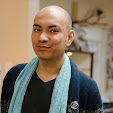 After work, I headed over to the New School to watch a panel discussion in response to the exhibition, High Times, Hard Times. Katy Siegel (the curator of the traveling show) was co-moderating the discussion with Anna Chave, with panelists Jack Whitten, Howardena Pindell, and Robert Pincus-Witten.
After work, I headed over to the New School to watch a panel discussion in response to the exhibition, High Times, Hard Times. Katy Siegel (the curator of the traveling show) was co-moderating the discussion with Anna Chave, with panelists Jack Whitten, Howardena Pindell, and Robert Pincus-Witten. It was an interesting discussion. Jack and Howardena both gave introductions about their work and the climate in which the pieces were created, emphasising racial, political, and sexual factors. Some of the panelists kept talking about the "master narrative" and how that after Clement Greenberg and October had passed, there seemed to be lack of an over-arching voice to direct the eye of contemporary artwork. They touched on how it was hard to verbalize abstract art and that the key that tied all of these works together was that they were all painting and questioning the expansion and limitations of the term. The show itself addresses a period of time that was largely over-looked by critics and art history.
I asked a question at the end of the discussion. The question that I asked was, "Does the very mounting of this show, the fact that many of the artists included in the show are teachers - with sway over their students, current market successes of participating artists and rises in publication interest, in some way predict that the artists and writers involved will become the new master narrative?" Katy Siegel emphatically and jokingly said, "YES!"
It is most interesting how these artists who "fought for a place at the table" may in fact become the artists who control the future of the table.

















No comments:
Post a Comment